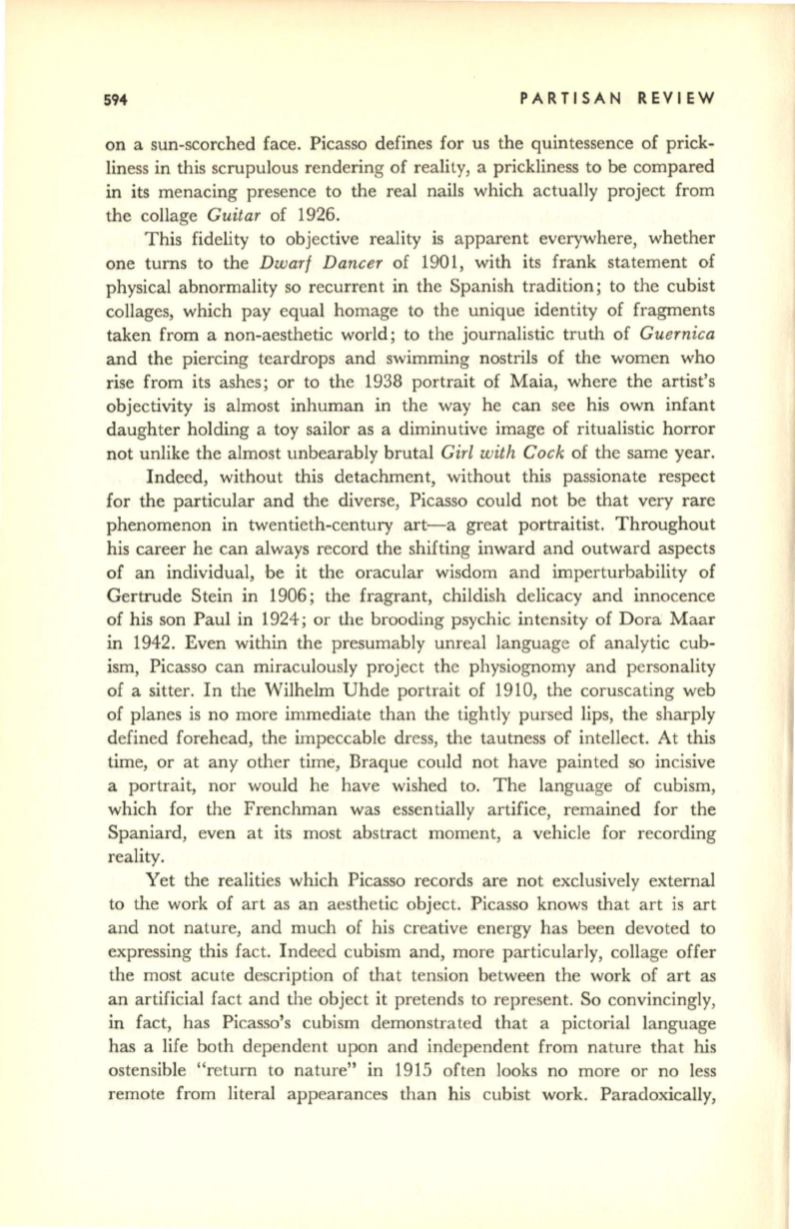
594
PARTISAN REVIEW
on a sun-scorched face. Picasso defines for us the quintessence of prick–
liness in this scrupulous rendering of reality, a prickliness to be compared
in its menacing presence to the real nails which actually project from
the collage
Guitar
of 1926.
This fidelity to objective reality is apparent everywhere, whether
one turns to the
Dwarf Dancer
of 1901, with its frank statement of
physical abnormality so recurrent in the Spanish tradition; to the cubist
collages, which pay equal homage to the unique identity of fragments
taken from a non-aesthetic world; to the journalistic truth of
Guernica
and the piercing teardrops and swimming nostrils of the women who
rise from its ashes; or to the 1938 portrait of Maia, where the artist's
objectivity is almost inhuman in the way he can see his own infant
daughter holding a toy sailor as a diminutive image of ritualistic horror
not unlike the almost unbearably brutal
Girl with Cock
of the same year.
Indeed, without this detachment, without this passionate respect
for the particular and the diverse, Picasso could not be that very rare
phenomenon in twentieth-century art-a great portraitist. Throughout
his career he can always record the shifting inward and outward aspects
of an individual, be it the oracular wisdom and imperturbability of
Gertrude Stein in 1906; the fragrant, childish delicacy and innocence
of his son Paul in 1924; or the brooding psychic intensity of Dora Maar
in 1942. Even within the presumably unreal language of analytic cub–
ism, Picasso can miraculously project the physiognomy and personality
of a sitter. In the Wilhelm Uhde portrait of 1910, the coruscating web
of planes is no more immediate than the tightly pursed lips, the sharply
defined forehead, the impeccable dress, the tautness of intellect. At this
time, or at any other time, Braque could not have painted so inclSlve
a portrait, nor would he have wished to. The language of cubism,
which for the Frenchman was essentially artifice, remained for the
Spaniard, even at its most abstract moment, a vehicle for recording
reality.
Yet the realities which Picasso records are not exclusively external
to the work of art as an aesthetic object. Picasso knows that art is art
and not nature, and much of his creative energy has been devoted to
expressing this fact. Indeed cubism and, more particularly, collage offer
the most acute description of that tension between the work of art as
an artificial fact and the object it pretends to represent. So convincingly,
in fact, has Picasso's cubism demonstrated that a pictorial language
has a life both dependent upon and independent from nature that his
ostensible "return to nature" in 1915 often looks no more or no less
remote from literal appearances than his cubist work. Paradoxically,


